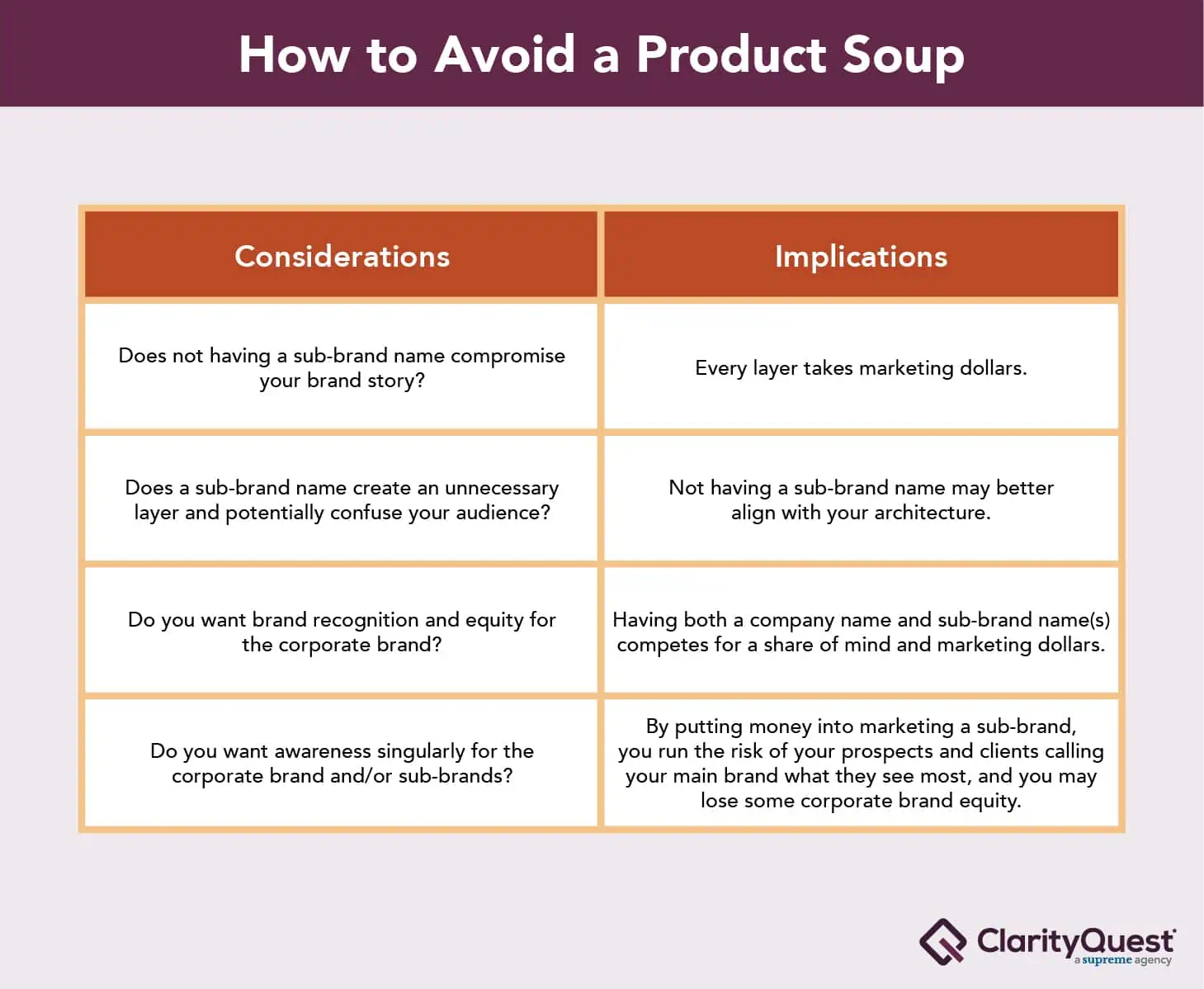
And it’s most likely because marketing is not included in product discussions. This is one of the most overlooked elements of your healthcare organizational strategy and planning.
Far too often, marketing is brought in late in the game, at the ‘we need a name’ stage. This is why our agency sees so much product soup from our clients— because time and attention haven’t been paid to the strategy behind a brand and product architecture.
Marketing needs to be involved from the beginning to:
- Establish product strategy and positioning
- Figure out where each product fits in the brand architecture
- Determine if you need to carve out another layer
- Decide if your new solution even needs a name
Notice naming is the last step. [Wink]
Sticking with the soup analogy.
The typical recipe
You may have gone through a recent merger or acquisition, and your suite of solutions just expanded, or you may be launching a new product/service or expanding into a new business division.
Regardless of the scenario, it is essential to step back from the naming vortex, dig out your brand architecture and discuss the impact this new widget will have, where it fits with your other products, and weigh the pros and cons of potentially adding another layer to your brand architecture.
If you need a refresher on the different types of brand architectures, a branded house model leverages the parent brand and attaches it to each child brand below it. In contrast, a house of brands model allows for unique child brands to be separate from the parent brand.
The worst thing you can do is ignore your architecture and move right into naming.
The risk of cooking product soup
Most organizations assume that a new product or service needs a new name. However, before doing so, it is critical to step back to assess the implications and consequences of doing so.
For every layer you add to your architecture, you need to have the marketing budget to support it. While it is appealing to develop creative product branding, this approach is often not sustainable with small marketing budgets. In many cases, brands (products) or sub-brands will each require brand identity creation, marketing messaging, website development, promotions, and ongoing support.
Feeding your sub-brands requires time, resources, and money. If you are asked to fragment your existing budget, that can bring risk and unintended consequences across your entire marketing program because you unable to give any one brand the right amount of flavors to deliver the nutrients of equity and awareness.
Some food for thought
Let’s dig in with some real-life examples of naming projects we’ve encountered:
1. Your on-premise solution is moving to the cloud. It didn’t have a name when it was on-prem, but now there is a desire to name it.
This is where the team should pause and have a conversation to ask the ‘why’ and the ‘what’ questions. Why do we need a name? Is it an internal or external name? If external, what is the point of entry for your business? Is it the cloud solution? If so, naming makes sense, and you should check out our best practices in B2B product naming. But if the entry point is through your corporate brand or another product/service, why name it when there is established value and you risk creating brand confusion?
2. You have one product or solution; should you name it when it is all you offer (today)?
This is an especially important strategic discussion, looking at what you offer today and what is on the horizon. For your existing product, where does the brand equity lie (do your sub-brands stand independently of the corporate brand)? If the answer is with corporate, it might make sense to hold tight and not name the product to leverage your corporate identity. Adding another name creates brand and budget fragmentation, including adding another name to the mix for your audience to remember.
As you look to the future, if you are developing products or solutions to break into a new industry, reach a new audience, or a different entry point, individual brand names might make sense if you have the budget and resources. But if the entry point stays the same, why compromise your brand value by adding another name to the mix?
Avoid a product soup with these key questions:
Need an experienced marketing partner who speaks fluent healthcare to support an upcoming product or solution launch, expansion, or M&A?
Don’t wait until it’s too late. Our healthcare tech marketing agency can help.



